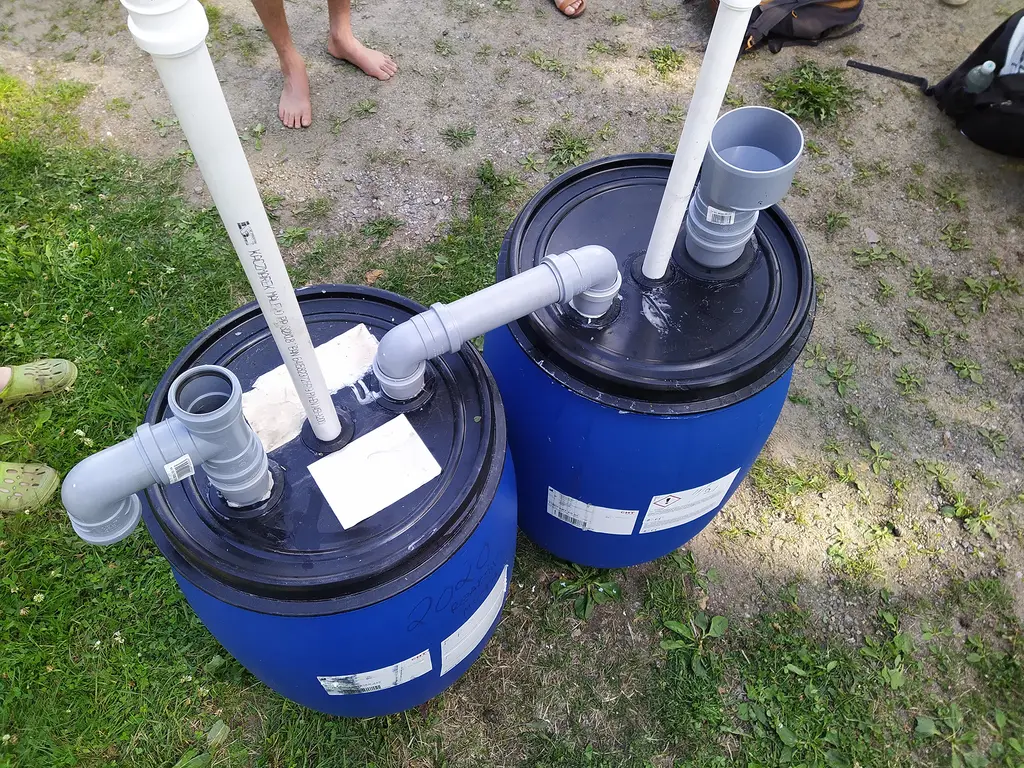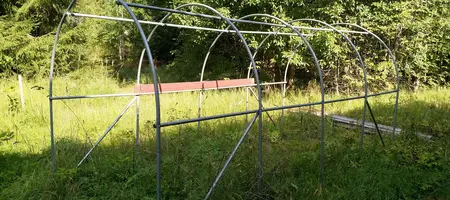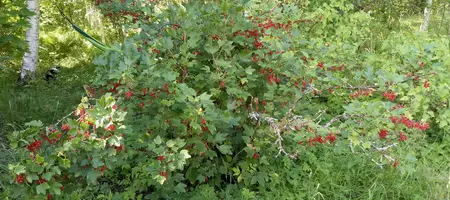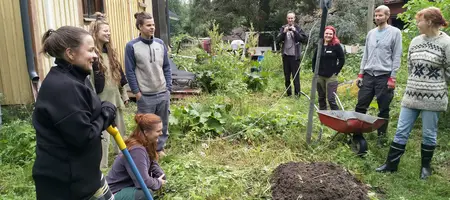For some month, even years, I claimed that my initial biogas system “Jean Luc” was too big for a family of two. A 1000 litre IBC digester with an Hydrolic Retention Time (HRT) of 20 days can be fed about 50 litres / day. The most we fed over the years is 10 litres / day. If we calculate the size of the digester based on the amount of food scraps and the HRT the resulting size is 200 litres.
It was time to come back to the original design and check what else could be done.
Goals
A new digester which is for me easier to handle than the IBC. A system for the northern countries that can either be put to hibernation or brought inside.
- Earth Care: nutrient recycling
- People Care: knowledge transfer, food during the workshop,
- Fair Share: money for the workshop
Since I already have a biogas digester design where the more general questions regarding biogas get answered this design extends on it.
Survey
The numbers are:
- 5 - 10 litre food scraps smoothy / day during the summer
- 10 – 20 litre food scraps smoothy / day during courses
- -30°C in winter outside
- -25°C in the winter in the greenhouse
- +5°C in the winter in the digester
- +21°C in the summer in the digester
- +45°C in the greenhouse
- difficult to get a supply of organic cow manure
- due to the insulation access to the digester is difficult
- usually 5 to 10 participants during a DIY biogas workshop
Analysis / Comparison
In order to see if the proposed barrel digester will solve my problems I run a PMI.
PMI
| Positive | Minus | Interesting |
| Two Barrel System | 1. Easier to handle due to smaller size. 5. The system can be unplugged resulting in two separate digester | 1. Smaller gas production. 2. May require more frequent feeding. 3. More sensitive to temperature variations. | 1. The design offers potential for modification or adaptation. 2. Could be linked to other systems to increase capacity. |
| IBC Digester | 1. Higher biogas production due to larger volume. 2. More suitable for bigger scale biogas projects. 3. More robust and durable design. 4. May require less frequent feeding due to larger capacity. | 1. More difficult to move or transport. 2. Potentially higher initial investment. 3. May require a more complex setup and maintenance. 4. Larger surface area may lead to more heat loss and may require more insulation. | 1. Well suited for scale up and replication. 2. Has proven performance in various DIY biogas projects. |
6 thinking hats
White Hat (Facts and Information): The system consists of two 120-liter barrels, interconnected to allow for the anaerobic digestion process. It's more portable and manageable in size compared to larger systems like the IBC. It requires regular feeding due to its smaller capacity.
Red Hat (Feelings and Intuition): Excited. New digester. New style, modular build. Let’s do it!
Black Hat (Critical Judgment): The system, due to its small size, will produce a limited amount of biogas. It may be sensitive to changes in ambient temperature, and may require regular maintenance and monitoring to ensure optimal conditions.
Yellow Hat (Positive Judgment): This system is a great way to start learning about biogas production on a small scale. Its small size makes it portable and manageable, it's affordable to set up, and it provides a hands-on learning experience about anaerobic digestion and renewable energy. It’s the ideal candidate for teaching people DIY biogas.
Green Hat (Creativity and Ideas): The design of this system can be modified or improved. For example, multiple Two-Barrel systems could be linked together to increase capacity. The barrels could be insulated to enhance heat retention, or placed in a greenhouse to utilize natural heat.
Blue Hat (Control of the Thinking Process): Looking at all the perspectives, it appears that the Two-Barrel system is an excellent learning tool for small scale biogas production. It's not without its challenges, but it also presents a number of opportunities for learning, experimentation, and improvement.
General thoughts
The two barrel is an opportunity and a good solution to scale down and still have biogas going.
Design
The actual design is a 2 barrel system which connects two 120 litre barrels. It combines the standard IBC design of a feeding pipe, a gas out pipe and an effluent out pipe with 2 blue barrels. The system is designed modular. In case of problem the system can be decoupled and then we have 2 digesters instead of one.
Part list
- 2 x 120 litre blue barrel
- 3 x 1m 50 mm pipe
- 1 x 1m 75 mm pipe
- 1 x 1m 32 mm pipe
- 2 x L 50 mm pipe
- 1 x T 50 mm pipe
- 2 x U100 Uniseal
- 3 x U150 Uniseal
- 1 x U200 Uniseal
- 2 x coupling for 32 mm pipe
- 2 x ball valve for 32 mm pipe (including converter)
- 3 way hose adapter
- some meters of garden hose
Tools needed
- Saw
- Hole saw for U100, U150 and U200 Unseals (44mm, 64mm and 101mm)
- Silicon gun + Silicon
- Sanding paper
- Knife
- Measuring tape
- Marker pen
- Vacuum cleaner (for all the microplastic)
- Liquid soap
Relative location
Our new digester, which I call the “Warp core”, will be put on the greenhouse floor in full sunlight. (Remember the temperature?) Since one barrel will only weight ~ 100 kg it will be possible to transport it, especially for end-of-season storage.
Implementation
For implementation we decided to go for a workshop, which we held on the 15th of July 2023. Besides building a digester we also dove deep into biogas theory. From requirements to types of digesters, storage systems, etc. we covered a huge ground of DIY biogas theory. The workshop was also a good way for us to finance the new digester. Uniseals, pipes, hoses and valves all cost money.
Maintenance
Maintenance should be easy:
- Decouple the two systems at the mid September and stop feeding
- Close the openings with caps and transport the two systems into its winter storage
- Check temperature in March / April
- If the greenhouse temperature doesn’t sink below freezing at night any more in Spring → bring them out of storage
- Get them on temperature using the solar air heater or other regenerative methods
- Start feeding fresh manure when the system passes +20°C
- Increase feeding according to temperature
Evaluation
The produced 2 barrel digester meets my needs. The only problem is the combination of the Insikerator and the feeding. Those are at two different locations and I need to find a solution for it.
As I wrote before DIY small scale Biogas aligns well with PC ethics. It produces energy, cycled nutritions and in the Nordic Countries is a perfect conversation starter.
Further evaluation can be done when the system has been housed in its relative location.
Reflection
What worked well?
The workshop was on time. I used my workshop template to get it done. I actually upgraded it and it has now an even better teaching flow.
The workshop was fully booked and afterwards I was very happy about the outcome. I think it again served its purpose.
Since it is a rather small design the amount of tools used was appropriate.
Regarding Earth Care, People Care and Fair share I think we were right on track. This time we even captured all the microplastic with the vacuum cleaner :) - no pollution.
What didn’t work that well?
The system is experimental – not sure if we got everything right. Time will tell.
What would you change?
Designing a more integrated system. Making sure that everything biogas related is in one place.








